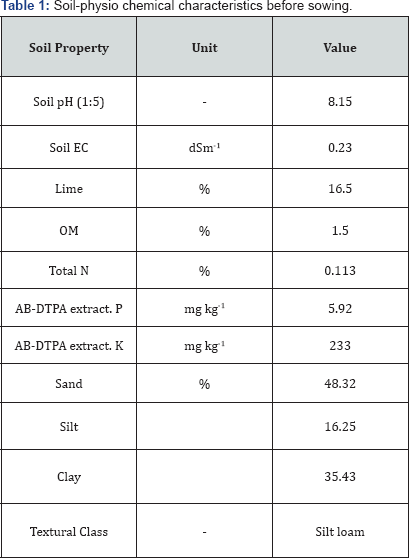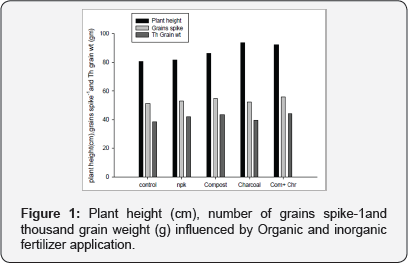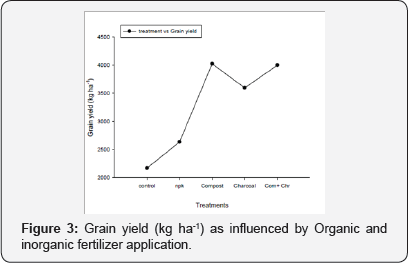Grain Yield, Yield Attributes of Wheat and Soil Physio-Chemical Charicteristics Influenced by Biochar, Compost and Inorganic Fertilizer Application
Imran1*, Nasar Jamal2, Ashfaq Alam3 and Asad Ali khan1
1Department of Agronomy, the University of Agriculture, Pakistan
2Department of Soil & Environmental Sciences, the University of Agriculture, Pakistan
3Department of Horticulture, the University of Agriculture, Pakistan
Submission: June 16, 2017; Published: August 28, 2017
*Corresponding author: Imran, Department of Agronomy, The University of Agriculture, Peshawar, Pakistan, Email: imranagrarian@aup.edu.pk
How to cite this article: Imran, Nasar J, Ashfaq A, Asad A k. Grain Yield, Yield Attributes of Wheat and Soil Physio-Chemical Charicteristics Influenced by Biochar, Compost and Inorganic Fertilizer Application. Agri Res & Tech: Open Access J. 2017; 10(4): 555795. DOI: 10.19080/ARTOAJ.2017.10.555795
Abstract
To attain sustainability in agricultural production the use of organic source of fertilization is essential. Both compost and charcoal could be the sources for enhancing physicochemical properties of poor soils. Now a day's compost has got considerable attention in socioeconomic conditions in Pakistan due to sudden increase in fertilizer prices and increased depletion of soil quality. Therefore present study was conducted to evaluate the effect of charcoal and compost on wheat yield and soil quality parameters. The experiment was conducted at ARI Tarnab farm Peshawar KPK, Pakistan during Rabi season of 2011-2012.The variety used was Pirsbak 2004. The experiment was laid down Randomized Complete Block Design (RCBD) with three replications, each replication with five treatments. The soil physio-chemical characteristics were greatly influenced by charcoal and compost combine application. The results obtained from the study revealed that maximum number of tillers (331), maximum productive tillers (312), promising number of grain spike-1 (56) and 1000 grain weight (44.1g) was recorded with combine application of Compost and Charcoal @ 5+5Mg ha-1 whereas highest biological yield (8710.2kg ha-1) and grain yield (4023.2kg ha-1) was noted with compost application @10Mg ha-1 as compared to control plot and other treatments. Highest plant height (93.7 cm) was observed with charcoal application @ 10Mgha-1 among combine application of compost and charcoal and inorganic fertilizers. On the basis of above findings it could be recommended that to improve the physio-chemical characteristics of soil and to attained highest biological and grain yield the combine use of compost and charcoal should be applied under the agro-climatic condition of Peshawar, Pakistan..
Keywords: Wheat (Triticum aestivum L.) charcoal; Compost; NPK; Soil Physio-chemical character
Introduction
In Khyber Pakhtunkhwa province wheat yield is low in rain fed areas due to harsh environmental conditions, which diminish soil organic matter, reduce soil microbial activity and nutrient retention. The yield of wheat both in barani and irrigated areas can be increased by using best agro- technology with suitable agriculture management practices. Challenge of acute food and energy crisis and sufficient food production at least for ever growing population at 2.6 percent per annum [1] should be made possible by the use of all available resources. It seems to be very quick and efficient method to use the mineral fertilizers but their energy costs are too high and that might not be environmental friendly and constraints may be in their use by the resource poor farmers. Wheat (Triticum aestivum L) belongs to the family Gramineae.
In Pakistan, wheat being the staple diet is the most important crop and cultivated on the largest acreages (8.303 million hectares during the growing season 2005-06) in almost every part of the country Pakistan grows about 8.176mha of wheat with total annual production of 19.767 million ton of grain giving an average yield of 24, 18kg ha-1. It contributes 13.7% to the value added in agriculture and 3.0 percent to GDP. Over the past three decades, increased agricultural productivity occurred largely due to the deployment of high-yielding cultivars and increased fertilizer use. But productivity of wheat is still low (around 2t/ha) because of many constraints along with poor soil fertility management. To attain sustainability in agricultural production the use of organic source of fertilization is essential. Both compost and Biochar could be the sources for enhancing physicochemical properties of poor soils. Now a day's compost has got considerable attention in socioeconomic conditions in Pakistan due to sudden increase in fertilizer prices and increased depletion of soil quality.
This might be due to increased costs for solid waste management and increased public awareness for wastes recycling. The process of composting provides sound way to manage large volumes of organic wastes in a comprehensive manner [2]. The organic matter in various forms and at various stages of decomposition has been used in soil in tons ha-1 for improvement of crop productivity. The crop yields especially of wheat are stagnant for the last couple of years. The use of organic manures and composted organic materials along with chemical fertilizers may be effective for further increase in crop yield.
Bio-char soil management, with associated increases in nutrient availability and pH, not only enhances crop yields and decreases risk of crop failure, but also opens new possibilities for cropping, i.e., high-value crops can be produced on sites that would normally not be suitable for production. Nutritious and easily marketable produce can improve cash returns and health among farmers. Charcoal helps to clean the soil of pollutants; it also acts as a soil conditioner. It is used as a top dressing for gardens, bowling greens and lawns. Charcoal also acts as a substitute for lime in soil additives because of the potash content, and it can be a little cheaper than lime. Study showed that adding charcoal to the rooting medium of peas produced a marked increase in the weight of the pea plants and in nitrogen fixation by the plants as compared to controls. It is suggested that the benefits derived from charcoal are due to its adsorption of toxic metabolites that are often released by plant tissues, especially when the tissues are damaged [3]. It is believed that addition of charcoal and compost to soils improves soil fertility and productivity. Limited information is available on charcoal and compost application to the soils of Pakistan. The present study was conducted to measure the physicochemical changes in soil and it its impact on wheat yield attributes.
Materials and Methods
The present study was design to evaluate the effect of charcoal and compost on wheat yield and soil quality parameters. The experiment was conducted at ARI Tarnab farm Peshawar KPK, during Rabi season of 2011-2012. The variety used was pirsbak 2004.
The experiment was laid down as per randomized complete block design (RCBD) with three replications, each replication with five treatments. Ten representative plants per treatment per replication were used for data recording.
Treatments:
i. T1 = Control
ii. T2 = Basal dose NPK
iii. T3 = 10 Mg/ha charcoal
iv. T4 = 5Mg/ha compost+5Mg/ha charcoal
v. T5 = 10Mg/ha compost
The field was well prepared by ploughing followed by planking. The dose of charcoal and compost were applied at the time of sowing. Sowing was accomplished with Row to Row distance of 30cm. The following observations were recorded.
Number of tillers per square meter
Tillers were counted in one meter row length at three different places in each sub plot and were converted into tillers m-2.
Number of productive tillers per square meter
Numbers of productive tillers were counted in one meter row length at three different places in each sub plot and was converted into productive tillers per m2.
Number of non productive tillers per square meter
Numbers of non productive tillers were counted in one meter row length at three different places in each sub plot and were converted into non productive tillers per m2.
Plant height, spike length (cm), number of grain per spike
Plant height was measured with a meter rod from ground level to the top of the spike. Three plants per sub plot were selected for recording plant height.
Spike length (cm)
Spike length was measured with a meter rod from peduncle node to the tip of the spike. Three plants per sub plot were selected for recording spike length and mean was calculated.
Number of grain per spike
Three spikes were taken from each treatment. Threshed and the number of grains counted, and the mean grain per spike calculated.
1000 Grain weight (g)
Ten random samples of 1000 grains each were weighted using electronic balance to calculate 1000 grain weight.
Biomass yield per unit area
Harvested crop which included grain+stem+leaves were weighed after drying in the sun to record biological yield in each sub plot.
Grain yield per unit area
After threshing and cleaning, all grains were weighed to record grain yield per sub plot.
Grain yield kg/ha
After threshing and cleaning, all grains were harvested to record grain yield per sub plot. Then converted it into grain yield kg/ha by using the formula.

Soil Analysis
Soil pH (1:5)
Soil pH was determined by the method as determined by Rhoads [4]. A 10g of soil sample was taken in a conical flask and added with 50mL of distilled water to make 1:5 soil-water suspensions. The suspension was shaken through a mechanical shaker for 30 min and then filtered through Whatmann no. 42.pH readings of the samples were noted after calibrating the pH meter against two buffers with pH values of 7.01 and 10.1
Soil texture
Soil texture was determined by the procedure as described by Koehler et al. [5]. Soil suspension containing 50g soil and 10mL of 1N sodium hexametaphosphate and sufficient water was dispersed on mechanical dispersion machine for 5min. The contents of dispersion cup were transferred to 1L cylinder and the volume was made to 1L. After vigorous shaking of suspension in cylinder, hydrometer readings were noted at 40sec and 2h, which represented percent silt+clay and clay in suspension, respectively. Temperature was also noted at both timings for correcting hydrometer readings. Sand, silt and clay were calculated on % basis. Textural class was determined using USDA textural triangle.
Soil organic matter
Soil organic matter was determined by using K2Cr2O7 as an oxidizing agent as described by Nelson & Sommers [6]. In this method, 1g soil sample was treated with 10mL of 1N K2Cr2O7solution and 20mL of concentrated H2SO4. After cooling 200mL of distilled water was added, filtered and titrated against 0.5N FeSO4.7H2O solution using orthophenolphthale in as an indicator. Titration was stopped and burette reading was noted with the appearance of maroon color as an end point. A blank was also run to correct normality of FeSO4.7H2O. Organic matter was calculated from the amount of K2Cr2O7 used in oxidation by the following equation.

Total nitrogen
Total N in soil and plant samples was determined by Kjeldahl method of Bremner [7]. Soil or plant sample of 0.2g was digested with 3mL of conc. H2SO4 in presence of 1.1g digestion mixture containing K2SO4, CuSO4 and Se in 100:10:1 ratio. After cooling, the digest was distilled with 20mL of 40% NaOH into 5mL boric acid mixed indicator solution. The distillate was titrated against 0.005M HCl.

AB-DTPA extractable K
Soil K was determined by AB-DTPA extracting solution as described by Soltanpour and Schawab [8]. K was determined by flame photometer (Jenway PFP 7).
Statistical analysis
The data obtained was analyzed statistically by computer using MSTATC package [12]. ANOVA were computed then means were compared through Least Significant Test [10].
Results and Discussion
Physio-chemical characteristics of the soil
The soil used for this study was silt loam, non saline with pH value of 8.15, highly calcareous, low in organic matter, deficient in N, P and adequate in K (Table 1 & 2).


Number of Tillers per square meter
Number of tillers m2 significantly varies among all the treatments. Maximum numbers of tillers were observed from the plot treated with compost and charcoal. Productive and non productive tillers m-2 were significantly (p<0.05) affected by different treatment combinations of charcoal and compost. Maximum number of productive tillers m-2 was produced by combine application of compost and charcoal when compared with other treatments. The increased number of productive tillers m-2 which was statistically at par with treatments fertilized with compost and charcoal @ 10Mgha-1 each. The opposite trend was noted for non productive tillers m-2. It may be due to the fact that nitrogen is an essential element for growth and development and thus promotes vegetative growth. Our results also indicated that compost application increased number of productive tillers m-2 because of greater content of nitrogen in compost. Similar results are also reported by (Table 3) [11-15].

Plant height, Spike length (cm) and number of grain per spike

Different levels of charcoal and compost application had significantly (p<0.05) affected spike length, grains spike-1, 1000 grain weight (Table 4). Maximum plant height was recorded in the plot treated with charcoal @10Mg ha-1 compared with other treatments. Our data also suggested that maximum number of grains spike-1 was observed in Pirsabak 2004 treated with Compost+Charcoal @ 5+5Mgha-1, while in case of 1000 grains weight maximum values were recorded in treatment of combine application of charcoal and compost. This may be due to the fact that maximum availability due to charcoal as it enhances catoin exchange capacity and absorption of nitrogen in case of compost resulted in more grains spike-1 and 1000 grain weight (Figure 1).

Biological yield and grain yield
Our results also suggested that significantly higher grain yield was produced by the variety Pirsabak 2004 treated with compost @10Mg ha'1 when compared with other treatments (Table 5). Similar results are also reported by [11-16]. Different levels of charcoal and compost application significantly (p<0.05) affected biological yield. Highest biological yield was observed in the treatments of compost @10Mg ha-1 (Table 4). The result is justifiable because compost is rich source of all nutrient especially nitrogen. These results agree with those reported by Woolfolk et al. [16] (Figure 2).
Our most of the soils are deficient in organic matter. Chemical fertilizers are much costly to compensate the soil fertility status. Although organic matter improves the efficiency of chemical fertilizers, yet availability of organic matter is very low, as most of the cattle feaces is burnt in from of dung. Green manuring is hardly done as it is an expensive practice. In conclusion it was observed that the use of organic sources as soil amendment i.e., charcoal and compost not only ensure sustainability of soil productivity but also contributes to yield attributes. The suitability of soil for crop production is based on the quality of the soil’s physical, chemical and biological properties. However with the conventional farming and chemical fertilizers the soil fertility attributes cannot be attain sustainable. Therefore it is recommended to explore new strategies for soil fertility. Charcoal residues are a worthless material to be used as soil amendment. In the present study charcoal and compost was utilized to improve soil physical and chemical properties (Figure 3).



Conclusion and Recommendations
It was concluded from the above study that compost and charcoal along with compost application not only enhanced yield of the crop but also improve the soil health (chemically & Physically) and productivity. Further research work is imperative for sustainable crop production and soil productivity in context of Pakistan.
References
- Qazilbash AA (2002) Population growth and its impact on environment. J Population & E Bulletin 2: 4.
- Lasaridi KE, Stentiford EI (1999) Composting of source separated MSW: an approach to respirometric techniques and biodegradation kinetics. In: International Symposium on "Composting of Organic Matter”. Kassandra-Chalkidiki, Greece.?
- Rondon M, Lehmann J, Ramirez J, Hurtado MP (2004) Biologial nitrogen fixation by common beans (Phaseoulus vulgaris) increases with charcoal additions to soils. J Integrated Soil Fertility Management in the Tropics pp. 58-60.
- Rhoads BL (1996) Mean structure of transport-effective flows at an asymmetrical confluence when the main stream is dominant. In: Ashworth PJ, Bennett SJ, et al. (Eds.), Coherent Flow Structures in Open Channels. John Wiley & Sons Ltd, Chichester, UK, pp. 491-517.
- Koehler FE, Moodie CD, McNeal BL (1984) Laboratory Manual for soil fertility, Washington State Uni. Pullman Washington, USA.
- Nelson DW, Sommers LE (1996) Total carbon, organic carbon and organic matter. In: Sparks DL (ed), methods of Soil analysis Part 3. (5th Edn), Soil Sci Soc Am Inc Madison, Wisconsin, USA. pp. 961-1010.
- Bremmer JM, Mulvaney CS (1996) Nitrogen Total. In: Spark DL (ed). Method of Soil Analysis. Part 3. Am Soc Agron 37: 1085-1122.
- Sultanpour PN, Schawab AB (1977) A new soil test for simultaneous extraction of macro and micro nutrients in alkaline soil, commum. Soil Sci Plant Anal 8(3): 195-207.
- Russell MJ, Hall AJ, Turner D (1989) In vitro growth of iron sulphide chimneys Possible culture chambers for origin-of-life experiments: Terra Nova 1(3): 238-241.
- Steel RGD, Torrie JH (1980) Principles and procedures of statistics. (2nd edn), McGraw Hill, New York, USA.
- Ling F, Silberbush M (2002) Response of maize to foliar vs. soil application of nitrogenphosphorus- potassium fertilizers. J Plant Nutr 25: 2333-2342.
- Bly AG, Woodard HJ (2003) Foliar nitrogen application timing influence on grain yield and protein concentration of hard red winter and spring wheat. J Agron 95: 335-338.
- Oko BFD, Eneji AE, Binang W, Irshad M, Yamamoto S, et al. (2003) Effect of foliar application of urea on reproductive abscission and grain yield of soybean. J Plant Nutr 26: 1223-1234.
- Saddiqui MH, Mohammad F, Nisar Khan M, Masroor M and A. Khan. 2008. Cumulative effect of soil and foliar application of nitrogen, phosphorus, and sulphur on growth, physicobiochemical parameters, yield attributes and fatty acid composition in oil of Erucic acid free rapseed mustard geneotypes. J Plant Nutr 31(7): 1284-1298.
- Otteson BN, Mergoum M, Ransom JK (2007) Seeding rate and nitrogen management effects on spring wheat yield and yield components. J Agron 99(6): 1615-1621.
- Woolfolk CW, Raun WR, Johnson GV, Thomason WE, Mullen RW, et al. (2002) Influence of late-season foliar nitrogen applications on yield and grain nitrogen in winter wheat. J Agron 94: 429-434.






























